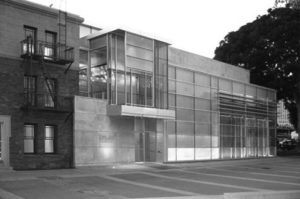Each season, arcCA DIGEST asks experts in the season’s theme – this time around, the ways that the lives of buildings unfold over time – to identify emerging issues, problems, opportunities, circumstances, etc., to which they believe architects should be alert. Here are their thoughts.

Self-driving cars, a global pandemic, bomb cyclones, and artificial intelligence: 50 years ago, a decade ago, even three years ago this all would have seemed the stuff of science fiction. Today, these are parts of our world—a world which seems to change at an ever-increasing pace. Yet, architecture is often seen as fixed, serving a specific program and acting as an archive of cultural and social histories and building practices. While that may be true to some extent, I suggest that most buildings are not static; they are unfixed, constantly changing through patterns of expected and unexpected uses, changing needs, and the wearing of time.
This long view is often missing from our practice, yet it is a perspective that allows us as architects to be active agents in positive social, technological, and environmental transformations over time. When we embrace practices of designing for change, we increase the lifespan of our projects, decrease carbon emissions, and reduce the amount of waste going to landfills. Designing with flexible spaces in mind orients us toward the horizon, and adaptive reuse of existing buildings further develops on this idea. Adaptive reuse has recently gained a renewed interest within our discipline and among those adjacent and outside of the building industry. It has all of the same sustainable benefits of designing for change, while also reclaiming what may be a culturally significant building for greater access. A lot of times adaptive reuse results in interesting and unexpected spaces as they are transformed for different uses, fostering and evoking creative solutions and working to preserve a local sense of place.
When designing a building it can be tempting to create a place that fits like a glove to specific programmatic needs; when we resist this urge, we have the opportunity to design spaces that adapt to the changing and unforeseen needs of our dynamic world.

The thing that’s really important about historic buildings—in addition to tying us to the past—is that they are an economic generator, too. Old buildings that are useful are great start-up spaces for new businesses, but they’re also valuable because of heritage tourism. People who go looking at historic sites spend more money than someone going to sports events. They spend much more money—perhaps three times as much. History and historic buildings are not just neat and cool and good for education and our children, but they’re also important for economic stability, for establishing an economic base.
[Adapted from the DESVGN video, “Valley Visionaries, Episode 1: Architectural Historian Karana Hattersley-Drayton”]

Preservation and adaptive reuse are changing for the better. There has been a noticeable shift in preservation practice recently that goes beyond restoring bricks and mortar. More conversations are taking place about which buildings and sites should be preserved, how these properties can be transformed and interpreted, and whose stories are being told. It is our responsibility to see that preservation is equitable and that the standards that guide our projects are flexible enough to accommodate change.
Two of the most important and often intertwined issues in preservation today are Social Equity and Environmental Resilience.
To address social equity, we need to collaborate with a broader community and elevate histories that are often untold. We need to ensure that smaller and less affluent communities have access to financial preservation incentives that large urban developments have utilized for decades, and we need to protect our most vulnerable resources from the effects of climate change.
Implementing environmental resilience requires openness and flexibility to allow historic sites to change so they can withstand new environmental forces. This could mean lifting buildings near water to lessen the impacts from storm surge and sea level rise; hardening buildings against wildfires; strengthening buildings to resist earthquakes; allowing buildings to generate their own energy.
It’s time for the standards that guide preservation to be reconsidered so they can accommodate these changes and respond to issues of environmental justice and climate change. This will lead to a more inclusive and more equitable world that will benefit us all.

The adaptive reuse of existing historic buildings often carries not only architectural significance but also cultural identities and a mission to ensure the endurance of that history. The creation of the National Center for the Preservation of Democracy in LA’s Little Tokyo, which included the former Hompa Hongwangi Buddhist Temple, offers an example.

In 1942, when Executive Order 9066 was put into effect the building ironically served as a staging area for the relocation of Japanese Americans to various internment camps. The rich architectural, cultural and community significance of the Temple provided the template for the transformation of the historic building, along with the new building addition, into the National Center for the Preservation of Democracy. It was created as a dedicated space to learn about the enduring fragility and ultimate success of individual and constitutional rights. The existing building includes an experiential exhibition “Fighting for Democracy” that tells the stories of seven individuals whose lives were forever changed by World War II. The contemporary addition is an exterior composition of a metal and glass curtain wall of various tints and textures which encloses the Forum and a wedge-shaped seating plan, enabling the audience to see and interact with each other – creating transparency to remind us that democracy is shaped by all people.
As more and more iconic buildings are preserved and renovated, there is the opportunity to include cultural history into the less architecturally significant adaptive reuse projects to reflect the arc of the evolution of the building and preserve, in a different context, the aspects of its transformation.

We are aware that the resources of our planet are finite, and yet every year we throw away millions of tons of perfectly good building materials in the form of construction debris. These building materials sit in our landfills producing methane when they could be reused—sequestering their carbon in new construction for decades to come. That is the environmental argument for reuse. The social argument is that the deconstruction and reuse of building materials provides quality jobs at all skill levels, right here in our communities. Lastly, there is the aesthetic argument. Salvaged building materials have lived, and they contain rich histories that imbue our spaces with character, texture, and life. With so many arguments in favor, we have to start reusing more.
Sure, there are logistical challenges, but architects are problem solvers by nature. It is true that deconstruction-and-reuse is more complex than our current system of knock-it-down, throw-it-out, but it is a lot simpler than many of the problems we tackle. We can design buildings to be disassembled, specify deconstruction in place of demolition, and salvage materials wherever we can. Let’s create the demand to drive the supply. Let’s embrace building material histories and incorporate them into our story of the future.





